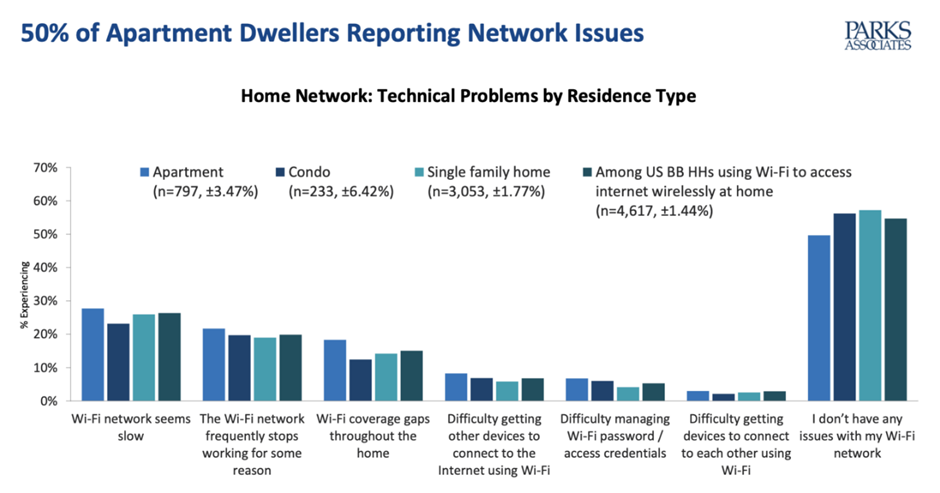Multi-Dwelling Units (MDUs) are residential buildings that house multiple families or individuals within a single structure. These buildings have gained popularity due to the increasing demand for affordable housing and urbanization in metropolitan areas. However, managing Wi-Fi connectivity in MDUs presents unique challenges.
The shared nature of the MDU Wi-Fi network often leads to problems like slow internet speeds, poor connectivity, and interference from other networks. To improve the overall resident experience and address these issues effectively, it is crucial to understand the statistics on Wi-Fi problems in MDUs. By grasping the scope and underlying causes of these issues, building managers and residents can take necessary steps to ensure reliable and high-performing Wi-Fi connectivity for everyone.
The Need for MDU Wi-Fi Networks
Wi-Fi has become an indispensable utility for residents across various housing types, including student housing, apartment complexes, and assisted living facilities. A survey by the National Multi-Family Housing Council in 2020 revealed that 91.7% of apartment residents consider high-speed internet important, with 74.8% valuing pre-installed Wi-Fi. Additionally, 41.5% of residents work from home, highlighting the need for a stable, secure internet connection.
Residents typically have multiple devices connected to the same network, including computers, smartphones, smart TVs, and gaming consoles. This necessitates modern Wi-Fi solutions that can accommodate numerous devices simultaneously. The quality of Wi-Fi can significantly influence a tenant’s choice of apartment.
MDU Wi-Fi networks must provide good coverage, easy access, and traffic separation to meet residents’ expectations. Luxury Multi-Dwelling Units are expected to offer blazing-fast connection speeds, a consideration that property owners might not have planned for in the past.
MDU Wi-Fi Network Challenges Faced by Residents
A recent Parks Associates report revealed that more than 31% of the US population resides in Multi-Dwelling Units, with 50% facing Wi-Fi-related problems. With an increasing number of individuals working from home, these internet connectivity challenges can adversely affect productivity and virtual meetings. The report shed light on additional Wi-Fi challenges that frequently trouble MDU residents, encompassing slow speeds, unreliable connectivity, and areas with poor coverage. These statistics emphasize the pressing need to address Wi-Fi problems in MDUs, ultimately enhancing the quality of life for the numerous individuals residing in such accommodations.

Source: Park Associates
Various factors contribute to the Wi-Fi issues experienced in MDUs, making maintaining a consistent and reliable connection difficult. Among the most prevalent causes are physical barriers like walls and floors, which disrupts Wi-Fi signals and weakens their strength. Tackling these challenges is crucial to ensure better internet experiences for MDU residents.
Besides physical obstructions, Multi-Dwelling Units face the challenge of shared networks, leading to network congestion and interference from other networks, particularly during peak hours. Consequently, this may cause slow internet speeds, dropped connections, and various connectivity problems. Moreover, MDU residents may desire greater control over their Wi-Fi network settings, but they might be limited in optimizing their connectivity or selecting their preferred service provider.
The high density of residents and their devices within the MDU can lead to network congestion, resulting in slower internet speeds and reduced overall network performance. With multiple Wi-Fi networks operating in close proximity, there can be signal interference, leading to disruptions and decreased signal strength for some residents. Additionally, Residents may not have the freedom to customize their network settings or optimize their Wi-Fi for specific devices or activities.
To address these challenges, some MDUs are exploring more advanced networking solutions, such as mesh Wi-Fi systems and enterprise-grade Access Points. These can offer residents improved performance, coverage, and security within the shared network environment.
Access Points: True Solution for Achieving Seamless MDU Wi-Fi Network
Deploying Access Points (APs) can indeed be a suitable solution to overcome the MDU Wi-Fi challenges faced by the residents. Here’s how Access Points can address the issues:
Overcome MDU Wi-Fi Speed Connection Issues with Access Points
Network Congestion:
Access Points can address network congestion by using technologies like band steering. Band steering directs devices to the less crowded 5 GHz band instead of the more congested 2.4 GHz band, reducing interference and freeing up capacity.
Interference:
Access Points equipped with advanced radio frequency (RF) management and automatic channel selection can mitigate interference. These features constantly monitor the Wi-Fi environment and automatically adjust the channel and transmit power to minimize interference.
Limited Bandwidth:
Modern Access Points support higher Wi-Fi standards 802.11ax (Wi-Fi 6), which offer greater throughput and capacity. Multi-User MIMO (MU-MIMO) technology in these standards enables Access Points to serve multiple devices simultaneously, improving overall bandwidth utilization.
Overcome MDU Wi-Fi Coverage Issues with Access Points
Strategic Placement for Even Coverage:
Access Points can be strategically placed to ensure uniform coverage throughout the MDU. Site surveys and predictive modeling help identify optimal locations, considering building layout and potential signal obstructions.
Individual Network Segmentation:
Access Points supporting Virtual LANs (VLANs) allow network segmentation. Each resident can have a separate SSID with its VLAN, isolating their network from others and improving security.
Resident Control:
Cloud-managed Access Points offer intuitive web interfaces or mobile apps that empower residents to manage their Wi-Fi settings. They can set up guest networks, prioritize devices, and monitor network performance.
Secure and Scalable MDU Wi-Fi Network with Access Points
Enhanced Security:
Enterprise-grade Access Points come with robust security features such as WPA3 encryption and Guest Wi-Fi isolation. These technologies protect the network from unauthorized access and data breaches.
Scalability:
Access Points can be easily added to expand the Wi-Fi coverage and capacity as the number of residents and devices increases. Centralized management systems streamline the process of scaling the network.
Modern Technology Support:
Access Points with support for the latest Wi-Fi standards ensure compatibility with newer devices, optimizing performance and future-proofing the network.
By utilizing these technologies and features, Access Points offer an efficient and effective solution to the MDU Wi-Fi issues, improving connectivity, security, and overall user experience.
In conclusion, MDU Wi-Fi has become an essential utility for residents. The increasing reliance on high-speed internet for work, entertainment, and communication demands seamless connectivity and reliable performance. However, MDU Wi-Fi networks face unique challenges, including network congestion, interference, and limited bandwidth due to shared networks and the high density of connected devices. Modern Wi-Fi solutions, such as Access Points, are vital to meet the residents’ expectations and enhance their overall living experience. Access Points offer improved coverage, enhanced security, individual network segmentation, and scalability, making them the true solution for achieving seamless MDU Wi-Fi networks.




.svg)
















